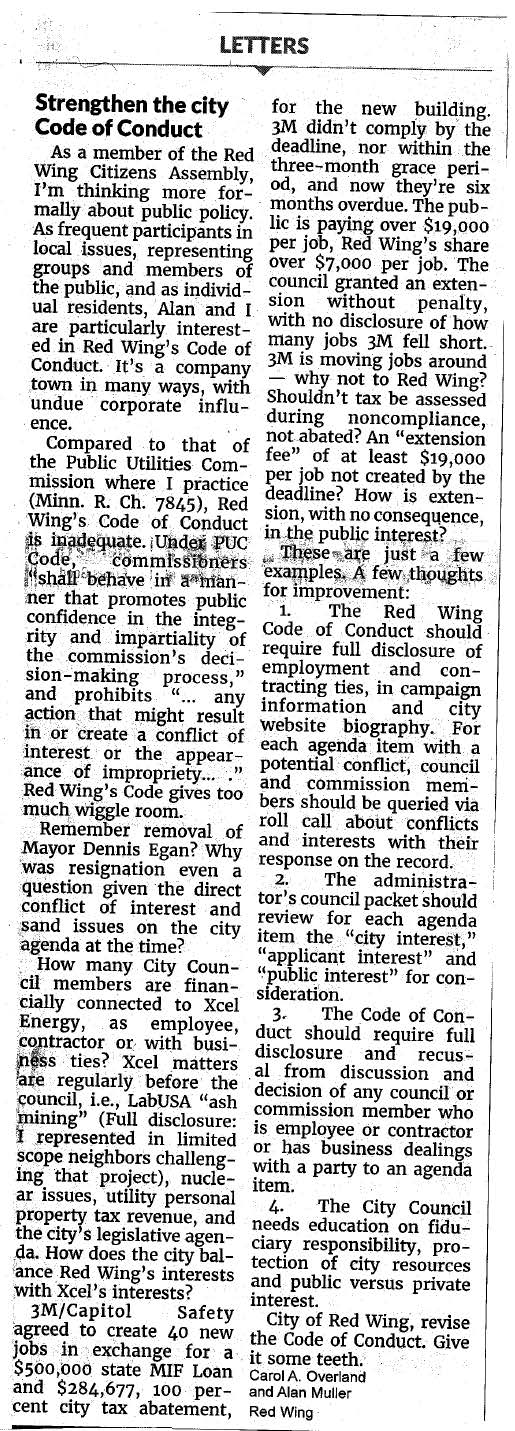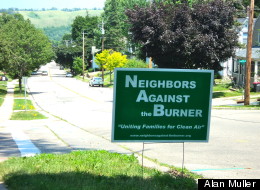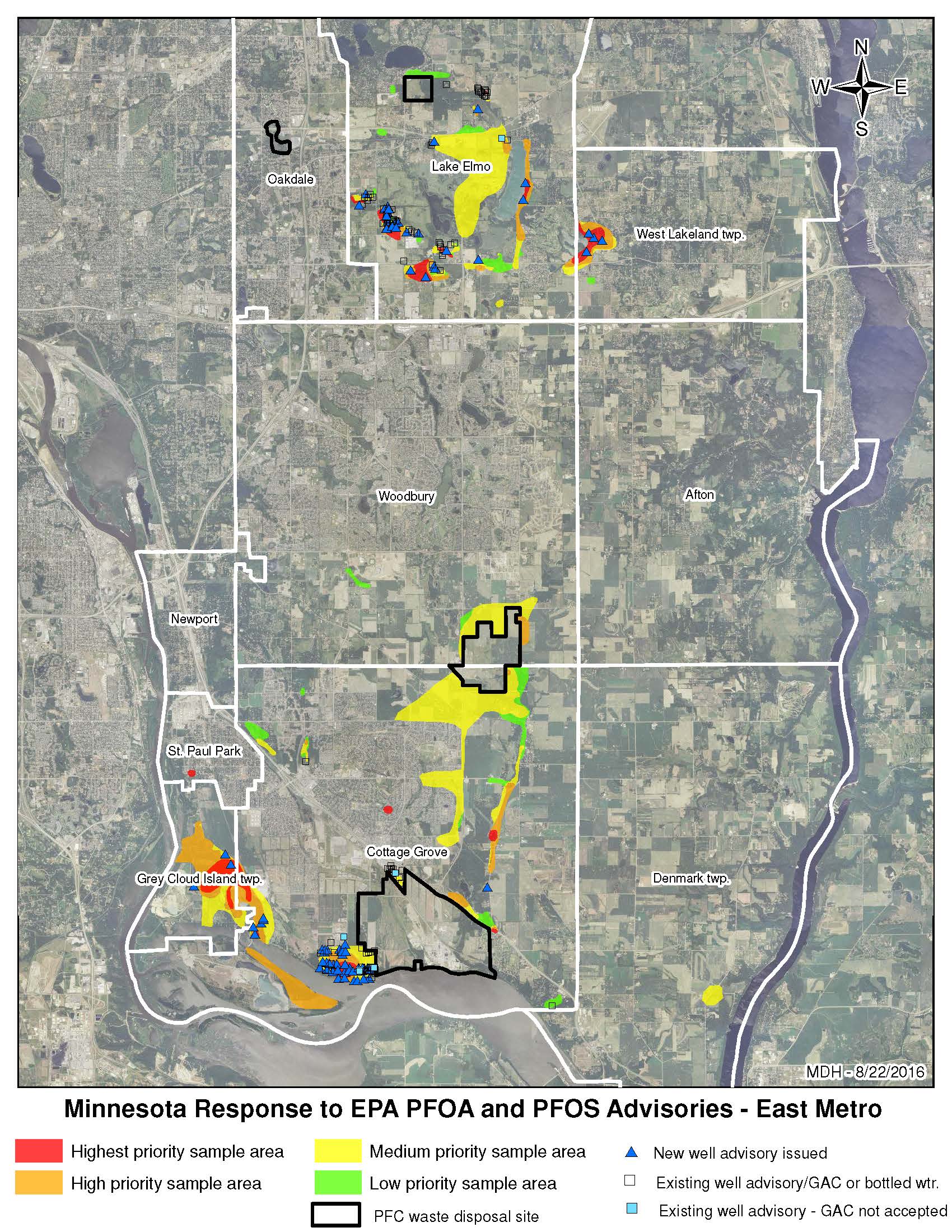Overland’s June LTE in RW Republican Eagle
June 29th, 2017

Dept. of Health & 3M’s PFC/PFOA contamination
August 23rd, 2016
3M has gotten away with poisoning the water of Minnesota, and the Dept. of Health has taken some protective and/or remedial measures, but it’s not nearly enough. Isn’t it a wake-up call that we need a “Drinking Water Health Advisory” in this Land of 10,000 Lakes? Minnesota’s “Pollution Control Agency” has not been proactive on this, and we’ve known about 3M’s contamination for how long? This is why we need the EPA! The EPA is leading the charge, and Minnesota’s Department of Health (MDH), as above, has “responded” to the EPA Advisories.
80 Washington County homes will get bottled water as state reviews new pollution rules
In part:
The Dept. of Health page:
MDH Response to EPA Health Advisory for PFOS and PFOA
From the EPA’s page:
Basic Information
- Fact Sheet on PFOA and PFOS Drinking Water Health Advisories (May 2016)
- BLOG: Science Guides Public Health Protection for Drinking Water by Joel Beauvais
Technical Information
- FR Notice on the Health Advisories for PFOA and PFOS (May 25, 2016)
- 2016 PFOA Health Advisory
- 2016 PFOA Health Effects Support Document
- 2016 PFOS Health Advisory
- 2016 PFOS Health Effects Support Document
- 2016 EPA Response to Peer Review Comments
Provisional Health Advisories and Draft Health Effects Documents
Technical documents
- 2009 Provisional Health Advisory
- 2014 Draft Health Effects Document for Perfluorooctanoic Acid (PFOA)
- 2014 Draft Health Effects Document for Perfluorooctane Sulfonate (PFOS)
- Peer Reviewer Summary Report: External Peer Review of EPA’s Draft Health Effects Documents for Perfluorooctanoic Acid (PFOA) and Perfluorooctane Sulfonate (PFOS)
Peer Review
Criminal Charges Begin re: Flint Water
April 20th, 2016
Yesterday, Alan and I were in Hastings, and we were talking about the extreme pollution of 3M, and of DuPont in Delaware. In Flint, it appears that it’s being taken seriously, though these first three charged may just be the sacrificial offerings:
In Michigan, the dominos are starting to fall. Susan Hedman, former head of EPA Region 5, did the right thing, resigned, and quickly, but since then? Well, now the criminal charges have begun:
Flint water crisis: Criminal charges against three state and city workers
From the article:
I would hope they’ll go deeper and that more will be charged.
It’s different in Minnesota. 3M knew enough to stop manufacturing PFOA, but it was dumped and made its way into our water, there’s a lawsuit initiated by our Minnesota Attorney General, but no criminal charges:
Study finds link between 3M-made chemical and cancer
Lawsuits Charge that 3M Knew About the Dangers of its Chemicals
A few snippets from the above article:
… and (the red links are to EPA testing):
After the initial discovery of PFCs in drinking water near the Cottage Grove plant, 3M installed filtration systems on the water supply for the nearby community of Oakdale, provided bottled water for residents with private wells, and remediated three of its former dump sites. However, the most recent water tests, released by the EPA in January, still showed 25 detections of PFCs in wells that provide drinking water to Woodbury, Oakdale, and Hastings — all of which are near 3M headquarters — as well as in the Cottage Grove water utility, which serves more than 33,000 people.
In two wells in Oakdale, PFOS contamination detected by EPA tests released in January exceeded the provisional health levels set by the agency. And several Oakdale wells had PFOA levels higher than those that qualified residents to participate in a class-action suit against DuPont in West Virginia and Ohio.
The Minnesota Pollution Control Agency has a page on this, where dangers are minimized, and where not much has been posted past 2009 (note landowners with wells have to pay over $300 for testing their water!):
The 3M Cottage Grove Facility and Perfluorochemicals
Why has no one been charged at 3M? Why is this surface and ground water pollution not front and center?
What about the bad water in Pennsylvania from fracking, Dimock, PA comes to mind, and that was public knowledge over 7 years ago:
Gas in wells in Dimock Twp. PA
And remember that National Geographic article with astonishing photos way back in 2007 about the poisoned and dry wells in Wyoming? That was a decade ago. What’s been done?
Drilling in the West – in National Geographic this month
Alan was in Huff Post Monday!
July 4th, 2012
Alan Muller had a few more minutes of recognition for his work against incinerators.
The MPCA made its decision at the Board’s June 26 meeting, Alan’s testimony is kick-ass as usual, starting around 2:47. The Cottage Grove part starts about an hour into the webcast:
This time, it’s the Cottage Grove 3M Incinerator in Huffington Post this week:

(that’s a NAB sign out in front of our house, Barn Bluff visible way down the hill in the distance…)
3M Incinerator Can Burn Outside Hazardous Waste, Minnesota Says In Defeat For Residents
Bets Thorkelson’s opposition to 3M Co.’s hazardous waste incinerator began in the mid-1990s, when she learned that four moms of boys on her sons’ hockey team had breast cancer.
“About the same time, I had also noticed that many people on my street were starting to die of cancer, including a young boy from a form of lymphoma,” said Thorkelson, who lives in what she describes as a blue-collar neighborhood in Cottage Grove, Minn., about two miles from one of the St. Paul-based mega-corporation’s factories.
Her distrust of 3M grew when she received a diagnosis of breast cancer herself a decade later. And it mounted further when she heard about the company’s plans to truck in additional hazardous waste to use as fuel for an incinerator.
Last week, after three years of public meetings, petitions and pleas from Thorkelson and other residents, the Minnesota Pollution Control Agency approved a permit to burn non-3M waste, as well as materials confiscated by local law enforcement agencies, allowing the company to save as much as $2 million in natural gas. Neighbors said they fear it will add lead, mercury and other toxic pollutants to the air they breathe — on top of the water and soil contamination already blamed on the company.
No link has been proven between past 3M pollution and cases of cancer. However, the state of Minnesota is suing 3M over claims that the company polluted groundwater and surface water for more than 50 years with perflurochemicals, which scientific studies have suggested may cause cancer.
“The [incinerator] decision is very disappointing, though not surprising,” Thorkelson said. “Our community has now become the toxic dumping ground for U.S. industries.”
Knowing the permit would be controversial, the state Pollution Control Agency decided to involve residents in discussions concerning the permit, according to the agency’s Jeff Smith. “At the heart of the issue was whether the public felt like they were enough part of the process so that they were informed and had a say,” Smith said. “Over 15 additional restrictions that might not otherwise have been required were negotiated between citizens, the city and the company. At end of the day, we overachieved in involving the public.
“There will be no additional increases in pollutants beyond what 3M has been permitted to emit,” added Smith.
Representatives from 3M also emphasized that the air pollution coming out of their incinerator with the additional hazardous waste would not rise above historic levels , thanks mostly to updated equipment that traps most of the particles.
But are the regulatory limits enough to protect Cottage Grove children from developmental problems, asthma, even cancer? And were 3Ms historic pollution levels ever safe?
Alan Muller, who once promoted incinerators for DuPont, said he shares the community’s concerns over uncertain answers to both questions. He now helps advise opposition groups, including the Coalition of Concerned Cottage Grove Citizens.
“For every pound of lead that goes into the incinerator, a pound comes out,” said Muller. Toxic metals can’t be broken down like other particles, he explained, so they will either spew from the smokestack, end up in the ash that’s trucked to a landfill, or get treated with the plant’s scrubber water before winding up in the Mississippi River.
A little lead can potentially cause a lot of harm, especially to a child’s developing brain. The U.S. Centers for Disease Control and Prevention recently acknowledged the risks by lowering the threshold for lead poisoning.
“It’s not that hard to find out hazardous waste incinerators are a bad scene. But this is a political, not a tech, issue,” said Muller. “The idea of weakening environmental regulations to revive the economy is not localized. Unfortunately, the same bogus arguments continue to be made all over the country.
“I never had a feeling that MPCA was acting in good faith on this,” Muller added. “Whenever you have a powerful corporation, with a lot of clout in the state, it’s hard for regulators to stand up to them.”
Fred Luden, a resident of Cottage Grove and a former 3M employee, returned from vacation in time to share his concerns at last Tuesday’s final hearing. He told the MPCA that it struck him while sitting on a lake with his grandkids just what a pristine environment he enjoyed while growing up in Minnesota, and how contaminated parts of the state have become today.
“You’d like to see at some point in time the ball go back the other way, to an environment that you can pass down to your children, grandchildren, great-grandchildren — hopefully,” said Luden, a member of the board of directors for the Coalition of Concerned Cottage Grove Citizens. “And that they will enjoy the same ability to drink the water, breathe the air, grow what they want in a garden and eat the fish again.”
That’s little comfort for some families who currently live in what they said is a contaminated environment.
“I have some peace of mind,” said Thorkelson, “knowing my grandchildren do not live within a 10-mile radius of the incinerator.”

